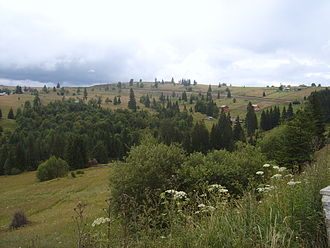Tihuța pass
| Tihuța pass | |||
|---|---|---|---|
|
Tihuța pass |
|||
| Compass direction | west | east | |
| Pass height | 1155 m | ||
| circle | Bistrița-Năsăud | ||
| Watershed | Bistrita | Dorna | |
| Valley locations | Mureșeni Bârgăului | Poiana Stampei | |
| expansion | Pass road | ||
| Map (Bistrița-Năsăud) | |||
|
|
|||
| Coordinates | 47 ° 16 '9 " N , 25 ° 1' 8" E | ||
The Tihuța Pass [ ˈtihutza ] ( Romanian Pasul Tihuța , Hungarian Borgói-hágó , also known as Borga , Borgo or Bârgău Pass ) is a mountain pass in the Eastern Carpathians , in the Bârgău Mountains , in the north of Romania . It is located at an altitude of 1200 m .
The pass road Drum național 17 connects the city of Bistrița ( Transylvania ) in the west with the spa and winter sports resort Vatra Dornei in the east. Further east, the road leads across the Bukovina to the Republic of Moldova . It leads through sparsely populated areas of a low mountain range , where bears and wolves still have their home today. The pass divides the Eastern Carpathians into a northern and a central section.
Literary setting
The pass is, under the name Borgo Pass , one of the scenes of the novel Dracula by the writer Bram Stoker , published in 1897 , who never visited this place, but designed it according to his imagination.
Web links
- Florica Dura: Tihuța, well-known recreation area at the beginning of the 20th century , on December 20, 2011 from ziarul-bn.ro (Romanian) accessed on December 22, 2017
- Map showing the route of the National Road 17 over the Tihuța Pass
Individual evidence


